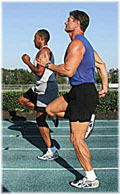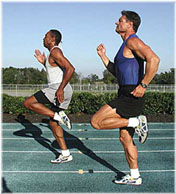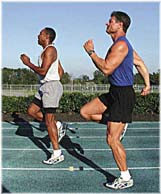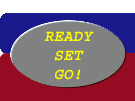|
This
plyometric drill has been called wall slides, glass wall,
and fast feet. Wall slides are halfway between the high
knee drill and the butt slaps drill.
While
moving forward, the knee is brought upward and high (fast).
The foot is limited to coming up in a straight path directly
under the body.
This
drill is called the “wall slide” because you visualize
an imaginary wall (from head to toe) directly behind you
as you move forward. And the foot slides up and down the
wall quickly.
See
how the foot slides up the wall in the following illustration.
  
This is a great drill for athletes of all ages. Nate Robertson,
my training partner, and I are both age 50.
This
drill is great for those wanting to increase top end running
speed. It teaches the feel of the “fly phase”
of sprinting. The
fly phase begins after 30 yards or so. Athletes not trained
in how to convert from the initial “drive phase”
of running, will significantly deter their top end speed.
And this drill will help the "turbo" gear of running
at top end speed.
Running
speed is not simply an issue of genetics. Speed is a learned
skill. And it can be developed - at any age.
All
Ages Benefit from Plyometrics
Children
can increase bone density, strength, and power through plyometric
jump drills, (Jumping improves hip and lumbar spine bone
mass in prepubescent children: a randomized trial, 2001,
Fuchs).
Adolescent girls that participate in plyometric training
increase bone density, (Effects of plyometric jump training
on bone mass in adolescent girls, 2000, Witzke).
Premenopausal
women maintain strength and power with plyometric training.
Continued training also reduces important risk factors later
in life, (Detraining reverses positive effects of exercise
on the musculoskeletal system in premenopausal women, 2000,
Winters).
Adding
plyometrics to your workout
The
Ready Set Go Fitness plan uses standing and dynamic (moving
forward) forms of plyometrics that involve quick, powerful,
repeated movements of the stretch-shortening muscular cycle.
The first few sets in the plyometric workout call for the
traditional karate kicks - front, side and back.
Then, follow the karate kicks with the dynamic drills.
Initially,
perform only one set of the dynamic plyometric drills covering
10-yards in distance. And progressively build to two sets
of 15-yards with a walk-back recovery in-between.
With all plyometric drills, there should be lots of leg
action (up and down). However, the progress forward should
be equal to the speed of walking.
Scheduling
plyometric drills
Plyometric
drills are a regular part of the Synergy Fitness program
beginning at Fitness Level Two. Plyometric workouts
should be performed one day a week. Advanced athletes in
the Fitness Level Five category have plyometric drills
scheduled for two days a week.
Have
a great day!
Phil
Campbell, M.S., M.A., FACHE
Author Ready, Set, GO! Synergy Fitness for Time-Crunched
Adults
|


